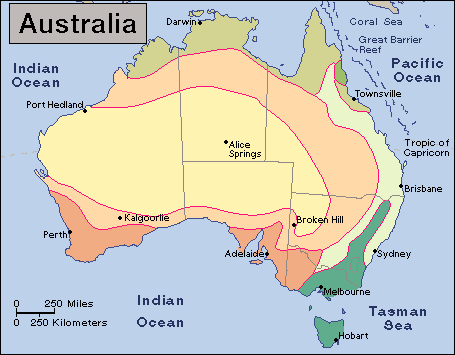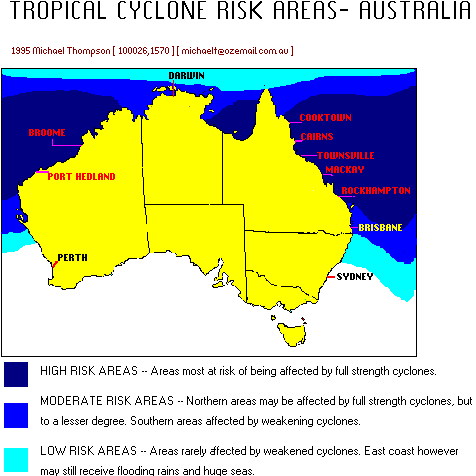Australian Climate - Overview
Australian Climate
Overview of General Climate
Seasons of the Aboriginal People
Comparison of Aboriginal Seasons with Western
Calendar
see also free on-line course When Good Rivers Turn Bad (contents)
Overview of General Climate


The northern third of Australia lies in the tropics and so is warm or hot the year around. The rest of the country lies south of the tropics and has warm summers and mild or cool winters.
In winter, many parts of the south have occasional frosts. But the Australian Alps and the interior of Tasmania are the only areas of the country where temperatures remain below freezing for more than a day or so at a time.

Australia receives most of its moisture as rain. Snow falls only in Tasmania and the Australian Alps. About a third of the country is desert and receives less than 10 inches (25 centimeters) of rain a year. The deserts are too barren even for the grazing of livestock. Much of the rest of Australia has less than 20 inches (51 centimeters) of rainfall annually. Few crops can be grown in these regions without irrigation. The heaviest rainfall occurs along the north, east, southeast, and extreme southwest coasts.
The east coast of Queensland is the wettest part of the continent. Some places along this coast receive as much as 150 inches (381 centimeters) of rain a year. Parts of the southeast coast and of Tasmania are the only areas of the continent that receive uniform amounts of rainfall the year around. Rainfall is seasonal throughout the rest of Australia.
The Seasons
Australia lies south of the equator, and so its seasons are opposite those in the Northern Hemisphere. The southern part of the continent has four distinct seasons. Winter, the wettest and coolest season in Australia, lasts from June through August. Summer, which is the hottest and driest season, lasts from December through February.
Tropical northern Australia has only two seasons--a wet season and a dry one. The wet season corresponds with summer and lasts from November through April. The dry season corresponds with winter and lasts from May through October.
The wet season brings heavy downpours and violent storms, especially on Australia's north coast. In 1974, for example, a cyclone almost leveled the northern coastal city of Darwin. Floods plague many parts of Australia during the wet season. However, droughts are usually a far more serious problem. Nearly every section of Australia has a drought during the country's annual dry season.
Water conservation measures prevent these droughts from doing serious harm in most cases. However, Australia also has periods when little or no rain falls even during the wet season. These droughts can cause severe water shortages.
Seasons of the Aboriginal Peoples - some examples
source: bom.gov.au- To the Yanyuwa people rolling coastal clouds indicate that flying foxes and certain bird species are about to start their seasonal migration.
- To the Wardaman people the appearance of march-flies in September or October indicate the end of the dry season.
- To the Walabunnba people when the mirrlarr (rain bird) calls out, it indicates that there will be a lot of rain.
- During the Djilba season in Nyoongar country, the flowers of the balgas (grass trees) emerge in preparation for the coming Kambarang season.
- The flowering of the boo'kerrikin (Acacia decurrens) is an indication for the D'harawal people, an end to the cold, windy weather, and the beginning of the gentle spring rains
- among the Rainforest People in far north Queensland there are
four seasons with various names:
- The Wet Season - January - February - March - when the green cicada sings it is time to move from the coast to the uplands rainforest to collect bush turkey eggs and harvest rainforest nuts
- The Cool Season - April - May - June
- The Dry Season - July - August - September
- The Stormy Season - October - November - December
- To the people of D'harawal country during Marrai'gang, when the cries of the Marrai'gang (quoll) seeking his mate can be heard, is the time when the lilly-pilly fruit begins to ripen on trees. However, when the lilly-pillys start to fall, it is time to mend the old warm cloaks from the last cold season, or make new ones, and begin the yearly trek to the coastal areas.
A comparison of various Aboriginal seasons from around Australia with the Western four season calendar:
European terms |
Indigenous Australian seasons |
|||
|---|---|---|---|---|
| Month | Season | Miriwoong calendar | Nyoongar calendar | D'harawal calendar |
| DEC | Summer | Nyinggiyi-mageny (wet weather time) | Birak, (dry and hot) | Parra'dowee, (warm and wet) |
| JAN | Burran, (hot and dry) | |||
| FEB | Bunuru, (hottest) | |||
| MAR | Autumn | |||
| APR | Warnka-mageny (cold weather time) | Bjeran, (cool begins) | Marrai'gang, (wet becoming cooler) | |
| MAY | ||||
| JUN | Winter | Makuru, (coldest, wettest) | Burrugin, (cold, short days) | |
| JUL | ||||
| AUG | Djilba, (wet days and cool nights) | Wiritjiribin, (cold and windy) | ||
| SEP | Spring | Barndenyirriny (hot weather time) | Ngoonungi, (cool, getting warmer) | |
| OCT | Kambarang, (long dry periods) | |||
| NOV | Parra'dowee, (warm and wet) | |||


